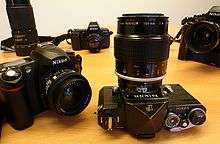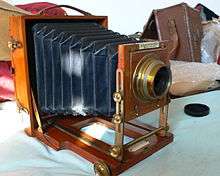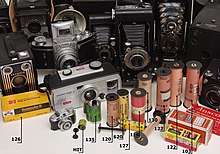Travel photography/Film
Film cameras are like LP records: they have dedicated fans who feel that the digital revolution has taken the soul away.
- This is about physical film for still photography. See Video recording for motion pictures.
| Travel photography Film • Full systems • Video recording • Wildlife photography |

Certainly film cameras can still produce fine images — after all, many of the world's most famous photos were taken with them — and some very fine older cameras are now remarkably cheap. A disadvantage is that, unless you shoot black-and-white and have your own darkroom, the cost of film and developing services adds up quickly.
This article covers using film cameras for travel. For digital options see the general Travel photography article and the article on more advanced systems at Travel photography/Full systems.
Equipment
Used film cameras are a bargain in today's market; used professional film equipment often sells for less than even a low-end digital camera.

Most travellers cannot afford and do not need today's top-of-the-line pro digital body — several thousand dollars and very heavy mainly because of enormous batteries — but a 20-year-old top-of-the-line pro film body is much lighter because it does not need the batteries and far cheaper; they sell for a few hundred dollars at a camera dealer or online auction site, and often less if you can find one in a thrift store or at a garage sale. Plenty of lesser old cameras are also available and often dirt cheap. Even adding the cost of having a technician do a CLA (clean, lubricate & adjust), the prices are still good.
Some features that are quite common on current digital cameras are relatively recent inventions; the first autofocus cameras appeared in the 1980s and the first image stabilisation systems around the turn of the century. Few film cameras have these features, and some of the ones that do have early versions with less-than-ideal performance.
The manual focus lenses from older cameras are also often a bargain and many of them can be used on current digital bodies. See our full systems article for discussion.
A few film cameras had built-in motorized film advance, making them significantly easier to use and a bit faster for bursts of shots. One example was the Konica Hexar RF with the Leica M lens mount. Another was the Canon T90 with the Canon FD mount. Canon changed their mount design in 1987 and has not produced FD lenses since then. Does an FD-mount body have a huge disadvantage since there are no new FD lenses? Or a major advantage since there were a full line of pro-quality FD lenses and many of them are now cheap? Probably both.
Most film cameras will run for months of use on the same little battery, and some are usable with no battery at all. This can be an important advantage for travellers going away from civilisation. A difficulty is that some cameras require batteries of a type that is no longer made.
Formats

There are many different film formats that have been used over the years.
Standard 35 mm film (36 by 24 mm negative) is much the commonest. It can usually be replenished fairly easily if you run out, and gives resolution roughly comparable to a current DSLR.
Some medium-format film cameras use a 6 by 6 cm format, more precisely a 56 by 56 mm negative. This gives resolution almost four times that of a 35 mm negative (3136 mm2 versus 864). Other formats in use are "645" (6 by 4.5 cm), 6x7 and 6x9. Resolution for any of these roughly matches a $10,000+ pro digital rig. Medium format cameras vary quite widely in cost, size and weight.
A large-format film camera has even higher resolution. A few travellers carry panoramic cameras (6 by 17 cm negatives) or large-format (4 by 5 or 8 by 10 inch) view cameras on their travels, but this is understandably rather rare.
Obsolete formats
Kodak (1884-2012) and Polaroid (1937-2001) flooded the consumer market with millions of inexpensive film cameras in their heyday in a vast array of incompatible formats. Only a select few, such as the standard 35 mm (24x36 mm) or the professional 120 medium-format (60x60 mm) roll film, have stood the test of time.
There are likely many low-end "point and click" cameras available second-hand for almost nothing. The catch? It will be difficult and costly (and in a few cases almost impossible) to find film and photofinishing if the camera follows not the 35mm standard but one of these formats that have come and gone:
- Many odd sizes of roll film, where an 8, 12 or 20 exposure film with a paper backing is wound onto a spool. A specialised camera store will still have plenty of 120 (and maybe 220, a 24-exposure version of the same roll with the backing paper missing) but most of the others were discontinued by the 1990s. 620, 127, 828, 116, 616 & 122 spool film all differ in mechanical dimensions; short of dealing with specialised vendors like Film for Classics or Frugal Photographer, finding film for these cameras is problematic. It may be possible to load 120 film onto old 620 spools (which were the same format on a thinner spool) in complete darkness (with a darkroom or changing bag), but – unless the camera is just a nostalgia piece – it's likely not worth the trouble just for the novelty of dusting off a simple, low-end "point and click" box camera from 1950 to see if it still can be made to work.
- 110 and 126 cartridge film were made from 16mm and 35mm stock (respectively), but the sprocket holes were different (one hole per frame, instead of the rows of cinema-style sprocket holes down both sides of standard 35mm), the film had a paper backing and the whole mess was packaged in a plastic cartridge with the feed and take-up reels built-in. Kodak's 126 Instamatic line (1963–1988) were cheap, entry-level fixed-focus cameras which were intended to be easy to use at the time. Millions of these cameras were sold, and they're worth almost nothing second-hand, but the lack of available film is a deal-breaker.
- APS (Advanced Photo System) was a format for automatic (electronically-controlled) still photography on a 24mm film cartridge, introduced under various brand names in 1996 and dead by 2011. The cartridge looked almost similar to the standard 35mm, but was completely incompatible and the image quality was no better. Too little too late, it never caught on as (by the turn of the millennium) digital photography was bankrupting legacy still photo film manufacturers.
- Disposable cameras are still available cheaply, but there's no easy way to reload film or anything else at home. One use and done.
- Instant cameras (such as the entire Polaroid line) had the film and the chemicals to develop the image into a finished print built right into the cartridge; some also included the battery in the film cartridge. The quality was lower, but they produced a usable photo in a minute or two. The cameras looked moderate in initial price, but the film cost as much as a few dollars per photograph - which got expensive quickly. The last users were in specialised applications, such as laboratories using instant camera film to record the display from scientific instruments. The old photographers' trick of storing film in the freezer until a few hours before use (which usually worked to allow camera film to be used well past its marked expiry date) wasn't an option, so the cameras were useless once Polaroid was bankrupt with the various incompatible instant film packs no longer manufactured. A Dutch firm Polaroid Originals did manage the impossible project of bringing a very limited film and camera selection back into production, but the cost is so high (given that "instant" results are now available from digital cameras for very little cost) as to be prohibitive.
There are also some specific film types for which colour processing is no longer available:
- The Kodachrome (K-14 process) colour slide film was marketed from 1935-2007; it used a complex development process which pretty much meant the film had to be sent back to Kodak (who included the developing in the price of the film). Few independent labs could (or would) offer the complex nine-step development process, despite the film's ability to preserve longer-lasting archival colours than the later, simpler (and now standard) E-6 process. Paul Simon fans will be heartbroken to learn that any remaining "new old stock" of Kodachrome film is useless as there's no one still able to develop it.
- There was a C-22 colour print film which pre-dated the modern C-41 process; available pre-1975 in film sizes 126, 127, 35mm, 120 and 620 but unlikely to turn up today, it is obsolete and colour processing is no longer available.
...and then there were the flash bulbs. Any modern camera has electronic flash, but a second-hand camera as a garage-sale find might have originally been designed to use single-use bulbs where the burst of light was generated not electrically but chemically - perhaps by burning a tiny amount of magnesium inside the bulb. The Magicube (a cube with four non-reusable bulbs for Kodak's Instamatic point-and-click cameras) used no battery, no electricity but once the bulbs had been used once each, they're done for. An originally high-end film camera (such as a 35mm single lens reflex) would usually accept an external flash – so the flash with the disposable bulbs could be replaced with a newer electronic flash – but the low-end Instamatic style point-and-click cameras didn't offer this option. Everything was fixed on one inflexible group of settings (f/11, 1/125s, focus at infinity) for outdoor use, so the only way to use the camera indoors was to find its specific, proprietary and non-reusable "flash cube" bulbs.
Film

Film comes in different film speeds, referring to their sensitivity to light, and therefore the shutter speeds you can use with them. Relatively "slow" film varieties (ISO 100-200) produce the highest quality images, but don't work as well indoors or in other low-light situations, where they require either the use of a flash or slow (blurry) shutter speeds. Higher speeds (ISO 400-800) are better in low light, but the images can look more grainy. Since you probably won't have the luxury of changing film depending what conditions you're in at the moment, try to anticipate how much you'll be in each; if you're going to be mostly shooting in low-light situations, a high-speed film will be more flexible but a little more expensive.
There are also different types of film: color negative, color slide, and black and white negative.
- Color negative film is the most popular option. When developed, negatives are produced, which have to be printed or scanned for you to enjoy the image. This film is labeled C-41 or CN-16. Color negative film is easy to find and any everyday photo lab will process It. Of the three film types, color negative is the cheapest to have processed.
- Color slide film (aka "transparency film") produces a positive image. To enjoy the image, it can be viewed in s slide projector, or scanned. Beginners should be aware that slide film has less exposure latitude, so light areas are more likely to end up washed out (overexposure), and dark areas turn out too dark to see detail (underexposure). Used correctly, it has long served as the best source of professional images for magazines and printed publications. This film is labeled E-6. Slide film can be hard to find and few labs process it.

- Black and white negative film is the oldest type of film. When developed, a negative is produced, which has to be printed or scanned for you to enjoy the image. Black and white film produces greyscale images - no color information is captured. It was used for many of history's most famous fine art, news, and candid photographs. It can also be used for a range of artistic effects, for example to show a silhouette or to emphasize texture rather than color. The finished image was more permanent than most colour processes; black-and-white processing was simpler in many ways (less expensive chemicals, less sensitive to developer temperature, better chemical shelf life, ability to make prints under red safelight) for amateurs printing photos in home darkrooms. In an era when printed newspapers were published on monochrome presses, black-and-white photos were routinely shot by news media and developed in the newspaper's own darkroom. Shooting black-and-white film is not a popular option today. Black and white film can be hard to find, and few labs process it. This film will be labeled "black and white film."
Black and white can be emulated in a digital camera, or in post-processing using any digital file (including scans of film). Some "black and white" film is a special type of color film. It can be developed in normal chemistry (I.e. by any lab that processes color film) but the resulting prints will appear in black and white (greyscale). Such chromogenic films will be labeled C-41.
Film can be fogged – or even ruined – by x-rays. Most modern airport x-ray machines use low enough intensity beams that a dose or two probably won't show up in your photos, but it's better to be safe than sorry. Also, older x-ray machines used in some countries might not be as film-safe. As a general rule-of-thumb, most x-ray units used for carry-on luggage are film-safe, while most units used for checked luggage are not. When flying, keep your camera and your film in your carry-on luggage, and give it to security to inspect by hand instead of running it through the x-ray machine. Carrying all of the film in one small clear plastic bag for hand inspection is one common approach.
In many airports, all carry-on material including films must be x-rayed.
Combining film and digital

It is also possible to carry both a film and a digital camera. It is fairly common to do this with two cameras that use the same mount so they can share lenses; this gives you a backup if the digital body fails or is stolen. See discussion in our full systems article.
Some people use film for their main camera but also have a small digital camera that fits in a pocket so they always have a camera on hand. Others shoot mainly digital but have a film camera in reserve for special applications.
For example, one way to get high-resolution photos is to take many shots with a digital camera and then stitch them together with software; many digital cameras and cellphones can stitch panoramas automatically and some do an adequate job of stitching both horizontally and vertically. Some enthusiasts prefer to just carry a medium-format film camera to get roughly similar results — you just need one shot and it can usually be hand held. Folding cameras are a common choice for this since they are quite compact when folded.